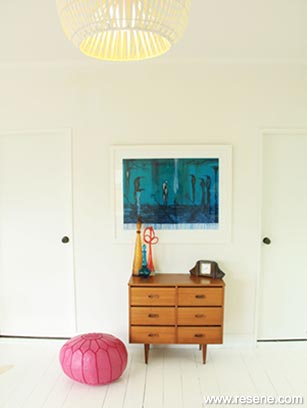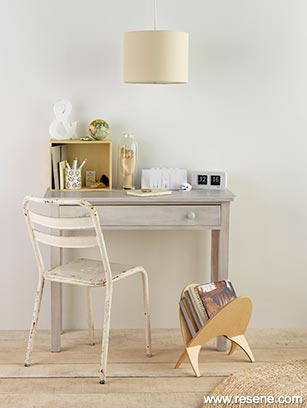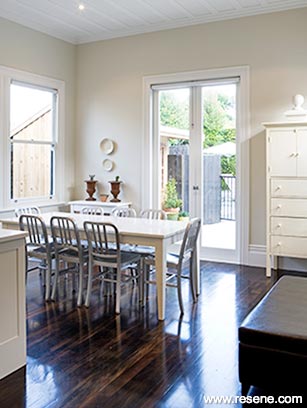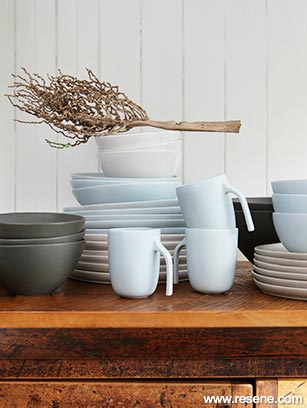From Habitat magazine - issue 20
Alabaster, chalk, ivory, cream… which is which? There are so many wonderful Resene whites to use.
You would think that all whites were created equal but in the world of paint, that’s just not so. When you’re decorating, there are myriad whites and off-whites from icy bright white, through to clotted creams and delicate ivories, all with varying touches of yellow, green, brown or grey to turn them into a huge cast of interesting shades.



Our search for just the right white for our homes is what makes the Resene Whites & Neutrals palette so popular, and their popularity is why the Resene top 20 paint colour list is dominated by neutrals each year. The classics are still going strong. With their yellow base, Resene Spanish White and Resene Pearl Lusta have the ability to lift a room and warm it visually. Try more ‘aged’ versions of these warm whites for a sophisticated look, like Resene Rice Cake, Resene Half Bianca and Resene Quarter Albescent White.
One of the big trends in whites in recent years is the emergence of those with more grey in them. In its subtlest form, this type of white has been hugely popular for a while now as Resene Black White and Resene Alabaster, but there’s a move to add even more black to result in a soft palest silvery white.
The other trend is for whites with a touch of green in them, like Resene Thorndon Cream.
Whites and off-whites pick up on other elements in the room. If you have off-white walls and a lot of green accessories, expect your walls to take on a green look. Use a strong blue rug or furniture and your walls will pick up on the blues.
Different parts of the room also reflect light differently. An off-white used under a window will look darker than the same colour used on the opposite wall. An off-white used on the ceiling will look much darker than the same colour on the wall because there is less light reflected. Use a half strength of your wall colour on your ceiling to ensure the two are well balanced.
The paint sheen level can also affect the way the colour looks. A flat paint will make the colour look muddier and denser, while a gloss finish will make it look cleaner and brighter. You can use this to your advantage by varying the gloss level to make a neutral colour palette more interesting and to highlight specific areas of the room.
Whatever type of white you’re after, here’s how to make the best use of the Resene Whites & Neutrals collection by understanding the colour codes.

Resene Quarter Tasman is the perfect backdrop colour for this rustic beachy setting
Beneath each paint swatch is not just the name but a code which starts with a letter. That tells you the base colour of the paint. So Y is for yellow, B for brown, G for green and N is for neutral (which means white, black, or grey once you put it with white).
Some paint colours cross from one base to another depending on their strength, for example, Resene Half Pearl Lusta’s code starts with a Y but Resene Quarter Pearl Lusta starts with a G. The science of paint is intriguing.
The red, orange, yellow and brown based whites are good for rooms that need warming up, say on the south side of the house, while those with a touch of grey and some of the greens and blues are good for taking the visual heat out of north-facing rooms.
Resene Black White (grey-based) has been the darling of the minimalist era for its cool architectural quality. Resene Alabaster is a favourite, and as a trim colour goes with just about any other paint colour.
The last three numbers of the colour code tell you where the colour sits on the colour wheel. Imagine red is at 0, then it moves into orange, yellow; green is at 180 then on it goes through blue and purple. So if you have two similar colours and one has 020 on the end and one has 180, this tells you that the 020 one is closer to the red part of the spectrum and the 180 one is closer to the greens. This is important with off-whites, with their subtle undertones.
It’s always best to try out a testpot of your favourite colour or colours. Paint two coats (all of a Resene testpot) on to a piece of cardboard, leaving a border around the edge, and move it around the space to view it at different times of the day and night. The subtle undertones of off-whites combined with your lighting and furnishings can make the colour seem very different to the colour chip, even though they are the identical colour. This is because the lighting, the amount of the colour and colour reflections from the furnishings can make your eyes view the colour quite differently.
The hot – or rather cool – new trend. Some people shy away from pale grey, believing it can be too cold for interiors but with the right warm or bright accessories, it looks sensational and sophisticated. Try it with bronzes and sandy shades.
These colours tend to change with the light quality, appearing warm one minute and cool the next.
Because green is made up of blue (traditionally a cool colour) and yellow (a warm one), these green-based whites have the ability to morph with the mood of the room. They suit our often garden-based settings or green outlooks too, and our bright light quality.
Q. Can you please suggest the best colour for a warm soft white for our bedroom?
A. There is no perfect ‘warm white’ as colours change so radically in all situations, and different types of light change how colour is seen. Try these colours to see if they will work for you:
These sophisticated, almost ‘aged’ whites visually warm a room without turning too sickly or yellow. They are particularly good for south-facing rooms or those with lots of reflected green from trees or plants.
Look at them side by side to see how different they are. Visit your local Resene ColorShop or reseller where they have A4-sized samples in the in-store Colour Library; if you place a sheet of white paper between them you will begin to appreciate their unique warm qualities.
If you have a colour query, go to Ask our Colour Experts page. Also check out the link on that page to see other colour questions and answers.
Search habitat magazine stories
Printed copies of habitat highlights are available from late March 2024 at Resene ColorShops and resellers, while stocks last. You can view back issues of habitat magazine online.
Specifiers:
If you have an idea, project or story that you think would suit habitat, we’d love to hear from you. Please drop us an email with your details and include photos if submitting a project.
Sign up for a DIY card and Save! Australia | New Zealand